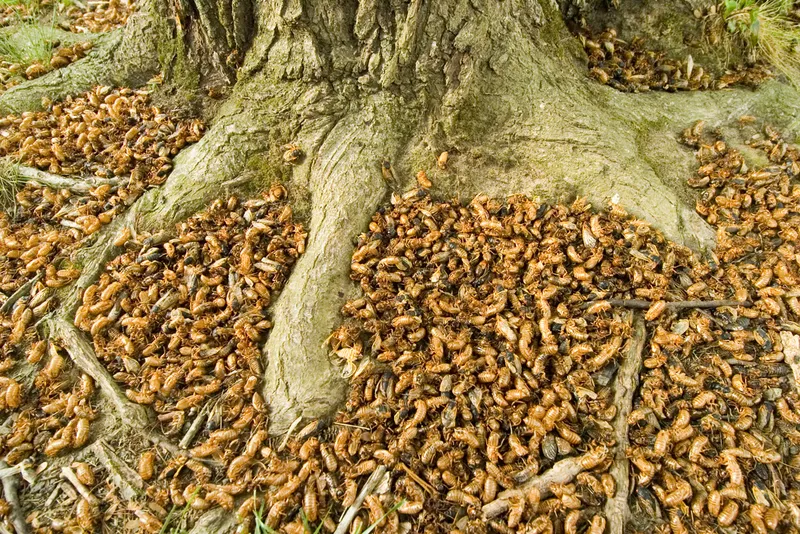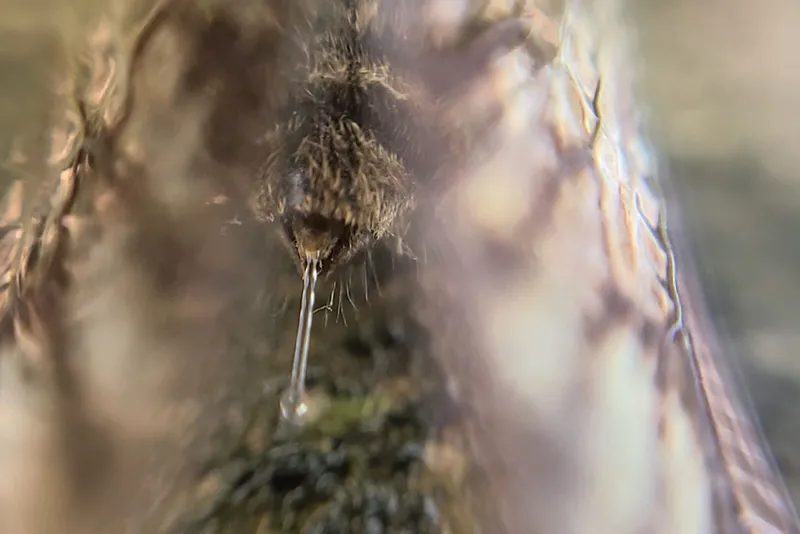Here’s a question you probably shouldn’t ponder while eating: what animal has the fastest pee on Earth? Elephants? Lions? Horses?
One surprising contender, according to a recent study in the journal Proceedings of the National Academy of Sciences: cicadas. After examining urine streams from across the animal kingdom, some (hopefully goggle-wearing) scientists found that the tiny insect can produce jets of pee with a velocity of up to three metres per second – that's about three times faster than an average man.
So far, so gross. But add to that the fact that billions, possibly even trillions, of them are soon set to emerge across the US in a once-in-a-200-year event and you may start to feel more than a little worried about your summer plans.
So, is it time to take cover and hide out until the cicada storm passes? According to the experts, maybe, but not for the reason you’d think…
What are cicadas, and why are they headed our way?
“Cicadas are really fascinating insects known for their unique life cycles and distinctive sounds,” Dr Elio Challita, lead author of the study into their urination, tells BBC Science Focus. “They belong to the order Hemiptera, which are sap-feeding insects and are found in temperate and tropical regions worldwide.”
Cicadas can be pretty big – about the size of a hummingbird in some cases – and they’re really, really, noisy. In fact, their chirping, clicking and snapping sounds can be as loud as a chainsaw.
“One of the most interesting aspects of cicadas is their prolonged juvenile stage, during which they remain underground for several years, feeding on plant roots. Depending on the species, this stage can last from a few years to 17 years,” Challita continues.
This year, in the US, two so-called ‘broods’ of periodical cicadas – one of which emerges every 13 years and another every 17 – are syncing up in some eastern areas of the US, in an event that hasn't happened since 1803, and won’t happen again until 2245.
If you’re curious to learn more about cicadas’ life cycles, you can read all about them in our explainer piece.
Is it time to prepare for a pee-pocalypse?
Before you start bulk buying canned food and toilet paper in preparation for a summer indoors, an entomologist at the University of Kentucky, Dr Jonathan Larson, tells BBC Science Focus that really, there’s not too much to worry about.
“I know for a lot of people the idea of this invasion of six-legged teenage bugs is something that might be out of a sci-fi movie, but it really is this beautiful, almost Mardi Gras life experience.”
While they’re large, cicadas are harmless to people, animals and crops.
Larson also points out that the cicadas in the recent study were a Peruvian species that emerge annually. They consequently spend more time feeding – and peeing – than the US species we’re expecting this summer.
Read more:
- Billions of cicadas are set to emerge in an ‘insect apocalypse’. Here’s what to expect
- Top 10 largest insects in the world
- Bugs on the brink: Why insects could be disappearing from your garden this year
“With the US species, we’re talking about one that feeds much less as an adult than some of these species in the study. The periodical ones that we have here, when they come out as adults, it’s all about finding a mate,” Larson says.
They will still spend some time feeding and peeing, though; Challita explains that periodical cicadas have been observed peeing in jets before. It’s even been caught on camera.
Another blessing (if we can call it that?) is that cicada pee is nothing like animal urine. As mentioned, cicadas feed exclusively on the xylem sap of trees – that’s the same stuff that forms the basis of maple syrup. What comes out, therefore, is a sugary, watery fluid known as ‘honeydew’.
Despite its delicious name, we don’t recommend you go around drinking cicada pee this summer, but at least you can feel slightly less gross if any does land on your head while you’re taking a stroll.
So, as Larson puts it, "You can leave your umbrellas at home with these cicadas." Phew.
"You'll want to watch your feet"
So cicada pee, while impressively fast, isn't too much of a problem. In fact, for Larson, the bigger issue will come when they die rather than when they go to the toilet.
“They do die in droves, so you'll have these big piles of dead ones. When they get stepped on, you can sometimes have slippery sidewalks. I would say that's the bigger liquid nightmare,” Larson says.
How bad could this get? Well, in 1990, there were reports of Chigoans having to use snow shovels to clear their sidewalks of the dead bugs.
Worse still, billions of bugs all dying and decaying at the same time are going to leave a nasty stench in the air. Some people have described this, urm, unique smell as the same as rotting nuts.

On the bright side, this process returns lots of nutrients, such as nitrogen, to the ground. So while they may be smelly, they do impose benefits on the ecosystems in which they end up.
How cicada pee could help build future robots
According to Challita, the fact that cicadas urinate in such powerful jets was surprising for two reasons:
- Urinating in jets like larger animals requires a lot of energy, so most insects don’t do it; they excrete in droplets instead. In particular, cicadas feed on sap, which has very little nutritional value, making their energetic expulsion all the more perplexing.
- Not only is it less energy efficient to pee in jets, but previous work suggested animals weighing less than one kilogram couldn’t because their orifices were too small to produce a thick jet.
Understanding this process is important for several reasons, not least because cicada populations number in the trillions and the effect of their excretion on the environment could be significant.
“We don't yet fully understand the ecological implications of cicada excretion for the surrounding flora and fauna, especially in the case of periodical cicadas,” Challita says.

When feeding, cicadas can consume 300 times their body weight in sap each day, and all that sap has got to go somewhere.
But the team has other applications in mind for this research too. The knowledge gained could help make jets and nozzles for tiny robots and have applications in additive manufacturing and possibly even drug delivery.
“Our work highlights the importance of studying the seemingly mundane aspects of animal biology, like excretion,” Challita concludes. “By investigating these processes, we can uncover fascinating adaptations and gain insights into how animals interact with their environment.
“It's also a reminder that there's still so much to discover about the natural world, even in the most unexpected places.”
About our experts
Elio Challita is a postdoctoral researcher at the Harvard Microrobotics Laboratory. Previously, he worked at the Georgia Institute of Technology, researching how ultrafast invertebrates (Insects, hexapods, arachnids) grapple with fluid dynamics challenges to carry out essential biological functions (feeding, excretion, predator avoidance, etc.).
Jonathan Larson is an extension entomologist and assistant professor at the University of Kentucky, providing insect expertise for people dealing with issues in urban landscapes, turfgrasses, nursery crops, greenhouses, and households. He is also co-host of the informative insect podcast, Arthro-pod.
Read more: